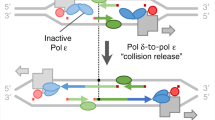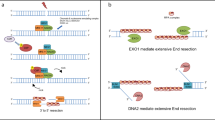Abstract
Genomes of all living organisms are constantly injured by endogenous and exogenous agents that modify the chemical integrity of DNA and in turn challenge its informational content. Despite the efficient action of numerous repair systems that remove lesions in DNA in an error-free manner, some lesions, that escape these repair mechanisms, are present when DNA is being replicated. Although replicative DNA polymerases are usually unable to copy past such lesions, it was recently discovered that cells are equipped with specialized DNA polymerases that will assist the replicative polymerase during the process of Translesion Synthesis (TLS). These TLS polymerases exhibit relaxed fidelity that allows them to copy past lesions in DNA with an inherent risk of generating mutations at high frequency. We present recent aspects related to the genetics and biochemistry of TLS and highlight some of the remaining hot topics of this field.
This is a preview of subscription content, access via your institution
Access options
Subscribe to this journal
Receive 50 print issues and online access
$259.00 per year
only $5.18 per issue
Buy this article
- Purchase on Springer Link
- Instant access to full article PDF
Prices may be subject to local taxes which are calculated during checkout







Similar content being viewed by others
References
Baynton K, Bresson-Roy A, Fuchs RP . 1998 Mol. Cell. Biol. 18: 960–966
Becherel OJ, Fuchs RP . 2001 Proc. Natl. Acad. Sci. USA 98: 8566–8571
Becherel OJ, Fuchs RPP, Wagner J . 2002 DNA Repair 1: 703–708
Bresson A, Fuchs RP . 2002 EMBO J. 21: 3881–3887
Cordonnier AM, Fuchs RP . 1999 Mutat. Res. 435: 111–119
Cordonnier AM, Lehman AR, Fuchs RPP . 1999 Mol. Cell. Biol. 19: 2206–2211
Dalrymple BP, Kongsuwan K, Wijffels G, Dixon NE, Jennings PA . 2001 Proc. Natl. Acad. Sci. USA 98: 11627–11632
Fuchs RP, Koffel-Schwartz N, Pelet S, Janel-Bintz R, Napolitano R, Becherel OJ, Broschard TH, Burnouf DY, Wagner J . 2001 Biochem. Soc. Trans. 29: 191–195
Fuchs RPP, Schwartz N, Daune MP . 1981 Nature 294: 657–659
Haracska L, Johnson RE, Unk I, Phillips B, Hurwitz J, Prakash L, Prakash S . 2001a Mol. Cell. Biol. 21: 7199–7206
Haracska L, Johnson RE, Unk I, Phillips BB, Hurwitz J, Prakash L, Prakash S . 2001b Proc. Natl. Acad. Sci. USA 98: 14256–14261
Haracska L, Unk I, Johnson RE, Johansson E, Burgers PM, Prakash S, Prakash L . 2001c Genes Dev. 15: 945–954
Haracska L, Unk I, Johnson RE, Phillips BB, Hurwitz J, Prakash L, Prakash S . 2002 Mol. Cell. Biol. 22: 784–791
Hughes Jr AJ, Bryan SK, Chen H, Moses RE, McHenry CS . 1991 J. Biol. Chem. 266: 4568–4573
Johnson RE, Kondratick CM, Prakash S, Prakash L . 1999a Science 285: 263–265
Johnson RE, Prakash S, Prakash L . 1999b Science 283: 1001–1004
Kato T, Shinoura Y . 1977 Mol. Gen. Genet. 156: 121–131
Kim DR, McHenry CS . 1996 J. Biol. Chem. 271: 20699–20704
Koffel-Schwartz N, Coin F, Veaute X, Fuchs RPP . 1996 Proc. Natl. Acad. Sci. USA 93: 7805–7810
Larimer FW, Perry JR, Hardigree AA . 1989 J. Bacteriol. 171: 230–237
Lawrence CW . 2002 DNA Repair 1: 425–435
Lemontt JF . 1971 Mutat. Res. 13: 319–326
Lenne-Samuel N, Janel-Bintz R, Kolbanovskiy A, Geacintov NE, Fuchs RP . 2000 Mol. Microbiol. 38: 299–307
Lenne-Samuel N, Wagner J, Etienne H, Fuchs RPP . 2002 EMBO Reports 3: 45–49
Ling H, Boudsocq F, Woodgate R, Yang W . 2001 Cell 107: 91–102
Lopez de Saro FJ, O'Donnell M . 2001 Proc. Natl. Acad. Sci. USA 98: 8376–8380
Masutani C, Araki M, Yamada A, Kusumoto R, Nogimori T, Maekawa T, Iwai S, Hanaoka F . 1999a EMBO J. 18: 3491–3501
Masutani C, Kusumoto R, Yamada A, Dohmae N, Yokoi M, Yuasa M, Araki M, Iwai S, Takio K, Hanaoka F . 1999b Nature 399: 700–704
Miller JH . 1983 Annu. Rev. Genet. 17: 215–238
Napolitano R, Janel-Bintz R, Wagner J, Fuchs RP . 2000 EMBO J. 19: 6259–6265
Nelson JR, Lawrence CW, Hinkle DC . 1996a Nature 382: 729–731
Nelson JR, Lawrence CW, Hinkle DC . 1996b Science 272: 1646–1649
Ohmori H, Friedberg EC, Fuchs RP, Goodman MF, Hanaoka F, Hinkle D, Kunkel TA, Lawrence CW, Livneh Z, Nohmi T, Prakash L, Prakash S, Todo T, Walker GC, Wang Z, Woodgate R . 2001 Mol. Cell 8: 7–8
Reuven NB, Arad G, Maor-Shoshani A, Livneh Z . 1999 J. Biol. Chem. 274: 31763–31766
Silvian LF, Toth EA, Pham P, Goodman MF, Ellenberger T . 2001 Nat. Struct. Biol. 8: 984–989
Steinborn G . 1978 Mol. Gen. Genet. 165: 87–93
Tang M, Pham P, Shen X, Taylor JS, O'Donnell M, Woodgate R, Goodman MF . 2000 Nature 404: 1014–1018
Tang M, Shen X, Frank EG, O'Donnell M, Woodgate R, Goodman MF . 1999 Proc. Natl. Acad. Sci. USA 96: 8919–8924
Trincao J, Johnson RE, Escalante CR, Prakash S, Prakash L, Aggarwal AK . 2001 Mol. Cell 8: 417–426
Wagner J, Etienne H, Janel-Bintz R, Fuchs RPP . 2002 DNA Repair 1: 159–167
Wagner J, Fujii S, Gruz P, Nohmi T, Fuchs RP . 2000 EMBO Rep. 1: 484–488
Wagner J, Gruz P, Kim S-R, Yamada M, Matsui K, Fuchs RPP, Nohmi T . 1999 Mol. Cell 4: 281–286
Zhou BL, Pata JD, Steitz TA . 2001 Mol. Cell 8: 427–437
Acknowledgements
We wish to thank Drs Anne Bresson and Dominique Burnouf for critical reading and helpful comments.
Author information
Authors and Affiliations
Corresponding author
Rights and permissions
About this article
Cite this article
Pagès, V., Fuchs, R. How DNA lesions are turned into mutations within cells?. Oncogene 21, 8957–8966 (2002). https://doi.org/10.1038/sj.onc.1206006
Published:
Issue Date:
DOI: https://doi.org/10.1038/sj.onc.1206006
Keywords
This article is cited by
-
Sequence dependencies and mutation rates of localized mutational processes in cancer
Genome Medicine (2023)
-
2,6-diaminopurine promotes repair of DNA lesions under prebiotic conditions
Nature Communications (2021)
-
The origin of human mutation in light of genomic data
Nature Reviews Genetics (2021)
-
Effect of episomally encoded DNA polymerases on chemically induced mutagenesis at the hisG46 target in Ames test
Genes and Environment (2020)
-
Regional emphysema score is associated with tumor location and poor prognosis in completely resected NSCLC patients
BMC Pulmonary Medicine (2020)



